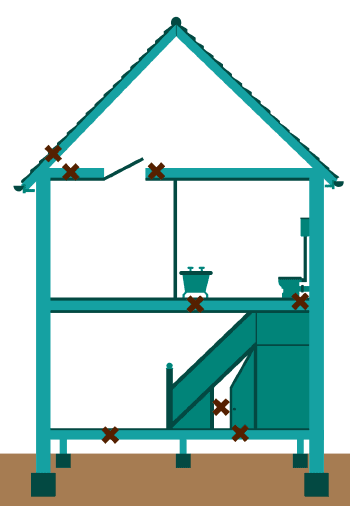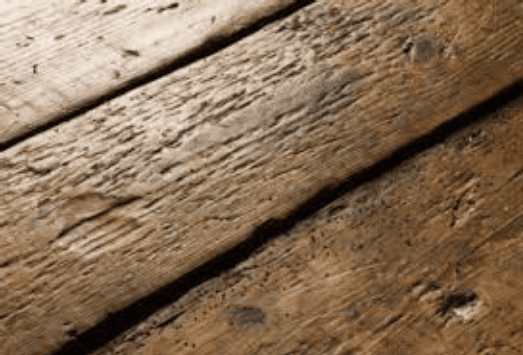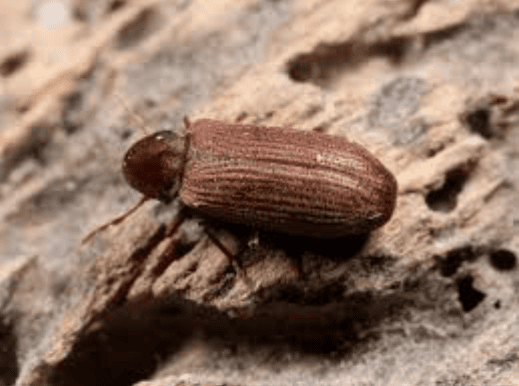Insect Attack.

People can get very worked up if they find evidence of “woodworm” in their property because they worry that it will spread and impact on the structural timbers of their homes. It is no surprise then that a number of claims and complaints arise where the surveyor has missed evidence of woodworm.
This article will explain the lifecycle of ‘woodworm’ and how to avoid potential claims and complaints.
What is woodworm?
Woodworm is the generic term used for the larvae of wood boring beetles.
There are several species of wood boring beetles in the UK. The types of wood they attack and their lifecycles vary depending on the species. It is the larvae that do the damage, the adult beetles themselves do not damage the timber other than to provide the next generation.
Damp conditions will generally encourage infestation – particularly the death watch and common furniture beetles.
The most common beetle is the Common Furniture Beetle.
Being alert to insect attack
The BRE has identified a number of key locations in a dwelling where insect attack is most common and when you are undertaking a survey you should examine these areas to see if there has been any insect attack
(see Fig 1):

- Timbers should be inspected with a torch to see if there are any adult flight holes
- If flight holes have been identified then note to see if there is any ‘dust’ (also known as ‘frass’). If the adults have emerged recently then often small piles of dust can be seen. The paler the dust the more recent it is likely to be (though note, if dust is not present, it may have been shaken or blown off).
Of course, it is not always possible to inspect the susceptible areas. Examples of limitation of inspection could be:
- Carpets or other fixed floor coverings preventing access to floor boards
- Fixed bath panels
- Fixed vanity units
- Inaccessible floor voids
- Owners possessions in under stair cupboards.
As with any limitation of inspection this should be carefully recorded on site notes, photographed and recorded on the HCS.
Assessing Insect Activity and the Extent of the Damage
This will vary depending on the species of beetle.
According to the BRE, infestations of Common Furniture Beetle, even where the infestation is quite old, is unlikely to be structurally significant. However, the home buying public can get quite upset when there is any evidence of woodworm, believing that their home will be structurally compromised, and so are likely to call in a ‘timber expert’.
And this is where it can all unravel. It is quite possible that many homes are treated for woodworm when in reality the insects are probably not active. The salesman may mention “the surveyor should have seen it” – a comment sure to spark a phone call to you and/or us.
“Every week 5000 British homes are sprayed with toxic chemicals to kill woodworm which probably left 100 years ago.The problem with woodworm is that when they leave the wood they also leave holes, and the holes are used by chemical salesmen to convince householders that they have a problem with insect infestation. But the truth is that the holes are probably 100 years old, and spraying them with chemicals is one almighty case of shutting the stable door after the horse has bolted.” (http://www.askjeff.co.uk/woodworm-the-hole-in-the-argument/)
The problem that we and the insurers have is that the homeowner calls in a firm, gets a quote (or even gets the work done) and then makes a claim against us for the cost of that work. Our difficulty is:
- Should the surveyor have seen the evidence of the attack?
- Was it live?
- Was it then reported appropriately

In all cases to date where we have had a complaint against a surveyor relating to woodworm, our difficulty has been to determine the above when all we have to go on are scribbled site notes and any photographs the surveyor took on site.
If the site notes are complete and accurate, the photographs are clear and well annotated and all limitations of inspection are recorded, we stand a good chance of being able to challenge the claim against the surveyor. However, very often this is not the case and so our insurers have had to settle on a number of claims which may not have all been fully justified but which we were simply unable to defend.
So, when on-site please ensure that you do the following:
- Take care to inspect all areas identified by the BRE as being at risk of wood boring insect attack (see Fig 1)
- Where there is anything that prevents you getting full access, mark this clearly on your site notes and take a photograph
- When you do get access, check evidence for woodworm – ideally by shining a torch along the wood
- When you find flight holes look carefully to see if they are likely to be ‘fresh’ and what size and shape they are (a photograph with an object to enable you to reference the scale is ideal and then enables you to check the likely insect later)
- If you find evidence of ‘frass’, is it likely to be ‘fresh’?
- If you find any evidence of damp in the property be particularly vigilant for attack.
If there is any suggestion that the attack is by any insect other than a common furniture beetle you should report this as a Condition Rating 3 because a further invasive (damaging) survey will be needed in order to verify the extent of the attack.

Where the attack is by common furniture beetle, because the attack is unlikely to cause structural damage, unless it is very severe, and because the treatments are all toxic pesticides then BRE recommends the following:
- If there are fresh flight holes/frass but the damage is not widespread then the appropriate remedial treatment will be to treat the affected timbers and the surrounding wood extending 300mm beyond the last flight hole
- If it is active and widespread then the appropriate remedial treatment will be to apply preservative to all the timbers in the affected floor or roof area
These points should be borne in mind when applying the appropriate condition rating using the SAVA Protocol.
We have also been in touch with the Property Care Association, the trade body representing firms who deal with structural maintenance, timber preservation, damp and condensation control, flood protection and remediation and the control and management of invasive weeds. They advise us that ‘Remedial surveyors’ from firms offering woodworm treatments, have traditionally described the condition or extent of an insect infestation as:
- Old and inactive,
- Active/ or old inactive local infestations
- Light active/ or old inactive infestations scattered throughout
- Heavy and intense activity
They told us that the term ‘severe’, although not commonly used, would imply heavy infestations to an area of timber components possibly causing some breakdown to sapwood edges (for example, floor boarding). They acknowledge that this does not follow any BRE guidance (or indeed any PCA guidance) but it is useful to know how a treatment firm might classify an attack.